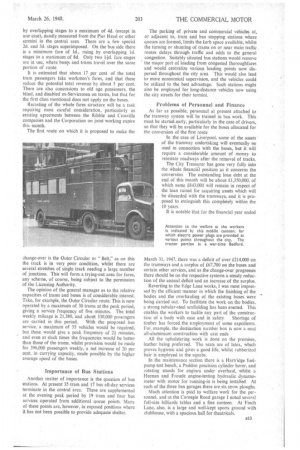DUNLOP
Page 46

Page 47

If you've noticed an error in this article please click here to report it so we can fix it.
Diamond
1665 Jubilee 19,.
by overlapping stages to a maximum of 4d. (except in one case), mostly measured from the Pier Head or other termini in the central area. There are a few special 2d. and 3d, stages superimposed. On the bus side there is a minimum fare of Id., rising by overlapping Id. stages to a maximum of 8d. Only two lid. fare stages are in use, where buses and trams travel over the same portion of route It is estimated that about 17 per cent. of the total tram passengers take workmen's fares, and that these reduce the potential total revenue by about 5 per cent. There are also concessions to old age pensioners, the blind, and disabled ex-Servicemen on trams, but that for the first class mentioned does not apply on the buses.
Recasting of the whole fares structure will be a task requiring most careful consideration, particularly as existing agreements between the Ribble and Crosville companies and the Corporation on joint working expire this month.
The first route on which it is proposed to make the change-over is the Outer Circular or "Belt," as on this the track is in very poor condition, whilst there are several stretches of single track needing a large number of junctions. This will form a trying-out area for fares, any scheme, of course, being subject to the permission of the Licensing Authority.
The opinion of the general manager as to the relative capacities of trams and buses is of considerable interest. Take, for example, the Outer Circular route. This is now operated by a maximum of 30 trams at the peak period, giving a service frequency of five minutes. The total weekly mileage is 21,380, and about 330,000 passengers are carried in this period. With the proposed bus service, a maximum of 35 vehicles would be required, but these would give a peak frequency of 2+ minutes, and even at slack times the frequencies would be better than those of the trains, whilst provision would be made for 396,000 passengers weekly, a net increase of 20 per cent. in carrying capacity, made possible by the higher average speed of the buses.
Importance of Bus Stations
Another matter of importance is the question of bus stations. At present 35 tram and 17 bus all-day services terminate in the central area. These are supplemented at the evening peak period by 19 tram and four bus services operated from additional queue points.' Many of these points are, however, in exposed positions where it has not been possible to provide adequate shelter. The parking of private and commercial vehicles at, or adjacent to, tram and bus stopping stations where queues are formed, limits the kerb space available, whilst the turning or shunting of trams on or near main traffic routes delays through traffic and adds to the general congestion. Suitably situated bus stations would remove the major part of loading from congested thoroughfares and would centralize various loading points now dispersed throughout the city area. This would also lead to more economical supervision, and the vehicles could be utilized to the best advantage. Such stations might also be employed for long-distance vehicles now using the city streets for their termini.
Problems of Personnel and Finance
As far as possible, personnel at present attached to the tramway system will be trained in bus work. This must be started. early, particularly in the case of drivers, so that they will be available for the buses allocated for the conversion of the first route
In the case of Liverpool, some of the assets of the tramway undertaking will eventually be used in connection with the buses, but it will require a considerable amount of money to reinstate roadways after the removal of tracks.
The City Treasurer has gone very fully into the vihole financial position as it concerns the conversion The outstanding loan debt at the end of this month will be about £1,350,000, of which some £843,000 will remain in respect of the loan raised for acquiring assets which will be discarded with the tramways, and it is proposed to extinguish this completely within the 10 years,
It is notable that for the financial year ended
March 31, 1947, there was a deficit of over £214,000 on the tramways and a surplus of £67,700 on the buses and certain other services, and as the change-over progresses there should be on the respective systems a steady reduction of the annual deficit and an increase of the surplus.
Reverting to the Edge Lane works, I was most impressed by the efficient manner in which the finishing of the bodies and the overhauling of the existing buses were being carried out. To facilitate the work on the bodies, a strong tubular-steel scaffolding has been erected. This enables the workers to tackle any part of the construc tion of a body with ease and in safety. Shortage of timber has forced the employment of some expedients. For, example, the destination number box is now a neat all-aluminium construction with cast ends.
All the upholstering work is done on the premises, leather being preferred. The seats are of latex, which proves hygienic and gives a good life, whilst rubberized hair is employed in the squabs, In the maintenance section there is a Hartridge fuelpump test bench, a Paddon precision cylinder borer, and rotating stands for engines under overhaul, whilst a Heenan and Fronde engine-testing hydraulic dynamometer with motor for running-in is being installed. At each of the three bus garages there are six snow ploughs.
Much attention is paid to welfare work for the personnel, and at the Carnegie Road garage I noted several full-size billiards tables and a fine canteen. At Finch Lane, also, is a large and well-kept sports ground with clubhouse, with a spacious hall for theatricals.




















































































